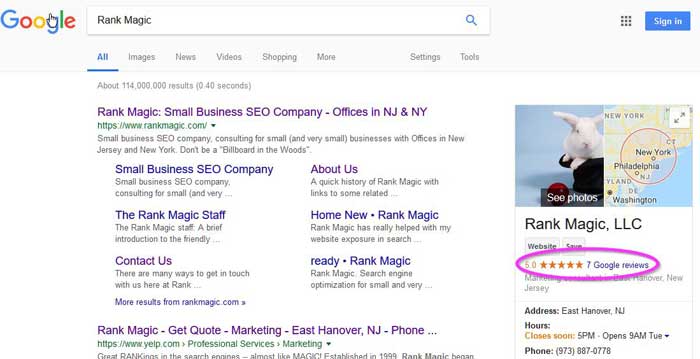How to Grow a Competitive Online Review Profile
Importance of your online review profile
 Online reviews, whether positive or negative, affect your reputation.
Online reviews, whether positive or negative, affect your reputation.- That in turn impacts your revenue. For example, BrightLocal found that 57% of consumers will only use a business if it has 4 or more stars.
- That’s because customers see your online review profile and believe those reviews. According to Inc. Magazine, 84% of people trust online reviews as much as personal recommendations from family and friends.
- Don’t go nuts. Watch your review velocity; review sites and Google certainly do. If you get too many reviews too fast, they may be seen as purchased links or spam and be filtered out.
- Diversity is important. If a citation site you’re listed on features reviews and you have none there, your citation is incomplete. It reduces your authority and your credibility.
Action Plan: how to manage your online review profile
Look yourself up by name
The first thing that jumps out at people is your Google Knowledge Panel at the top right. This is probably the most important place for you to have online review stars. If you don’t have any stars here, this is the first place to get them.
What other citations appear on the page? Your Facebook page may show up, perhaps a MerchantCircle page, maybe a Yelp listing, and maybe others. Do they have review stars? If not, those should be the second priority for you.
Online reviews don’t just happen
A good online review profile doesn’t just happen. If you have an unhappy customer their anger or disappointment provides built-in motivation for them to leave you a bad review. Happy customers are less likely to write a review without a little prompting.
Some businesses post a sign that says something like “We welcome your review on Yelp.” Or some variation on that. That plants the suggestion in the customer’s mind that they can (should) share their opinion of you.
Beyond that, you can also ask your customer for a review. Some businesses do that at checkout. Others that have customer email addresses send them an email request for a review with a link to your listing on the platform of your choice to make it easy for them.
Check out your niche
Do a keyword search like car repair shop in Morristown. Or New Jersey elder law attorney. Which industry sites and local directories show up? You may find something like a Morristown business directory. Or you may find a directory of elder law attorneys. If those directories accept online reviews, you need to have some there. If the site is fee-based, you may need to consider the relative value, but many are free.
Check out your competitors
Which of your competitors show up for your most important keywords? Search those keywords and make a note of which competitors are showing up on the first page or two. And then look up those competitors by name and see where they have citations with review stars. Those are all places you should also have reviews.
Go through at least the first three pages of results for each competitor to catch the most important citation/review sites.
Consider broader sites as well
There are a number of more generic sites that are powerful sources of online reviews. Some of the best ones include:
Monitor your online reviews and respond to them
It’s not enough to just ask customers for reviews. You need to respond to reviews as they appear. It’s normal for reviews to appear that you haven’t requested. And not all of those reviews will be glowing.
Responding to reviews promptly is associated with a 33% increase in conversions. We talk about the importance of monitoring and responding to reviews in our post Respond to Reviews and Get More Business.
As you might imagine, it can be quite time-consuming to monitor all of the places that host reviews for you. Fortunately there is the relatively easy solution. Most of our local SEO clients subscribe to a service that, among other things, sends them an email every time a new review is posted, with a link to that review so they can reply. If that’s of interest to you, reach out to me and I’ll explain how it works.



